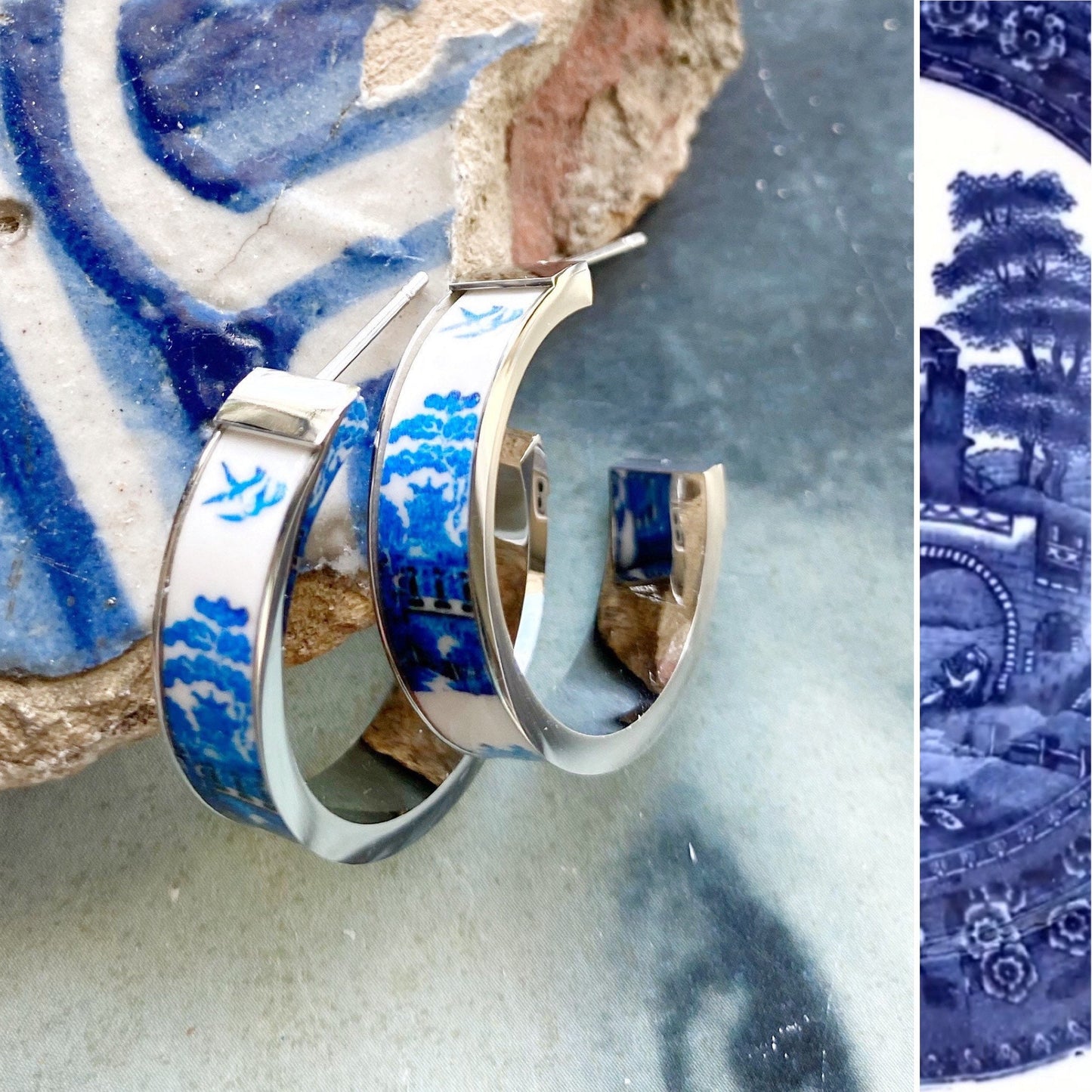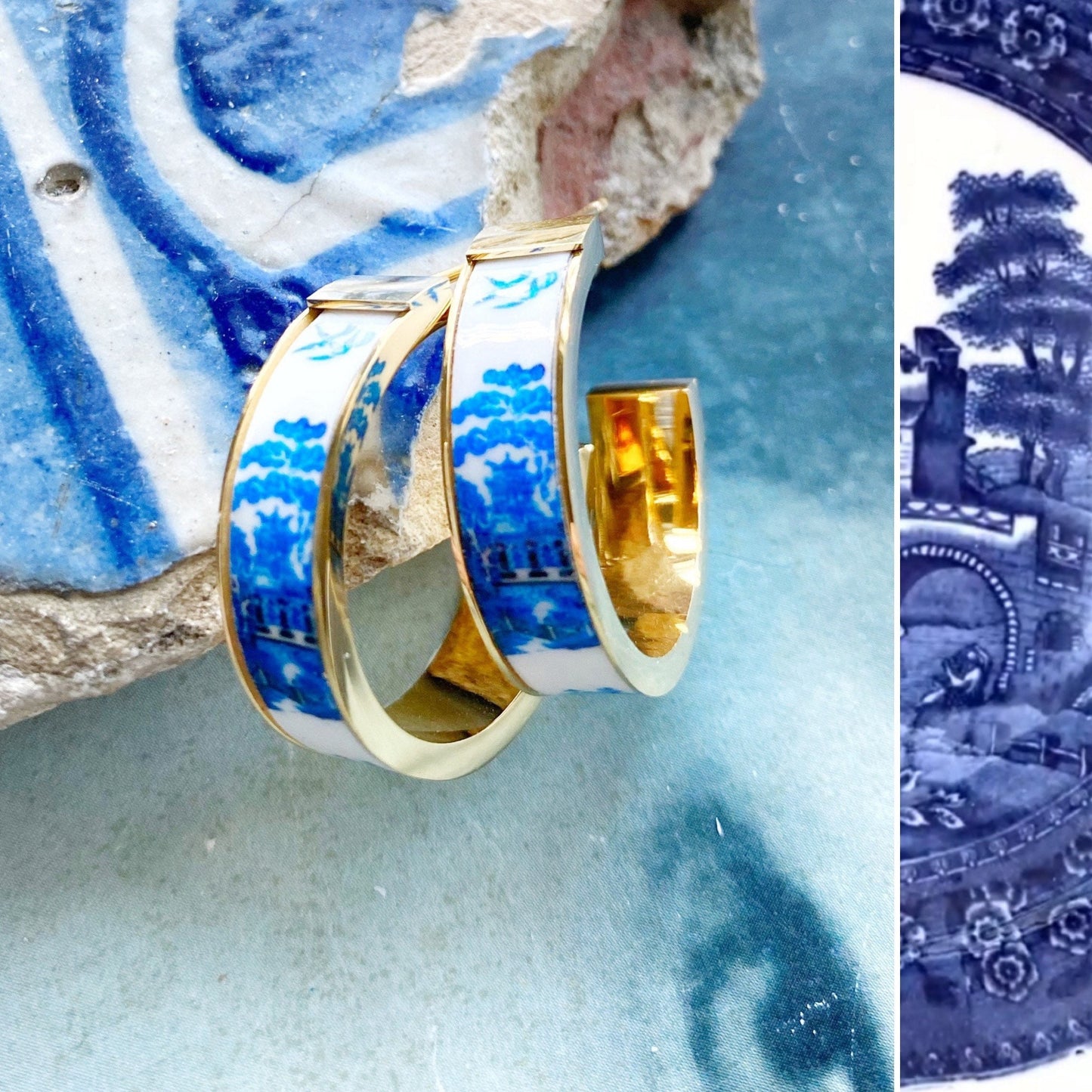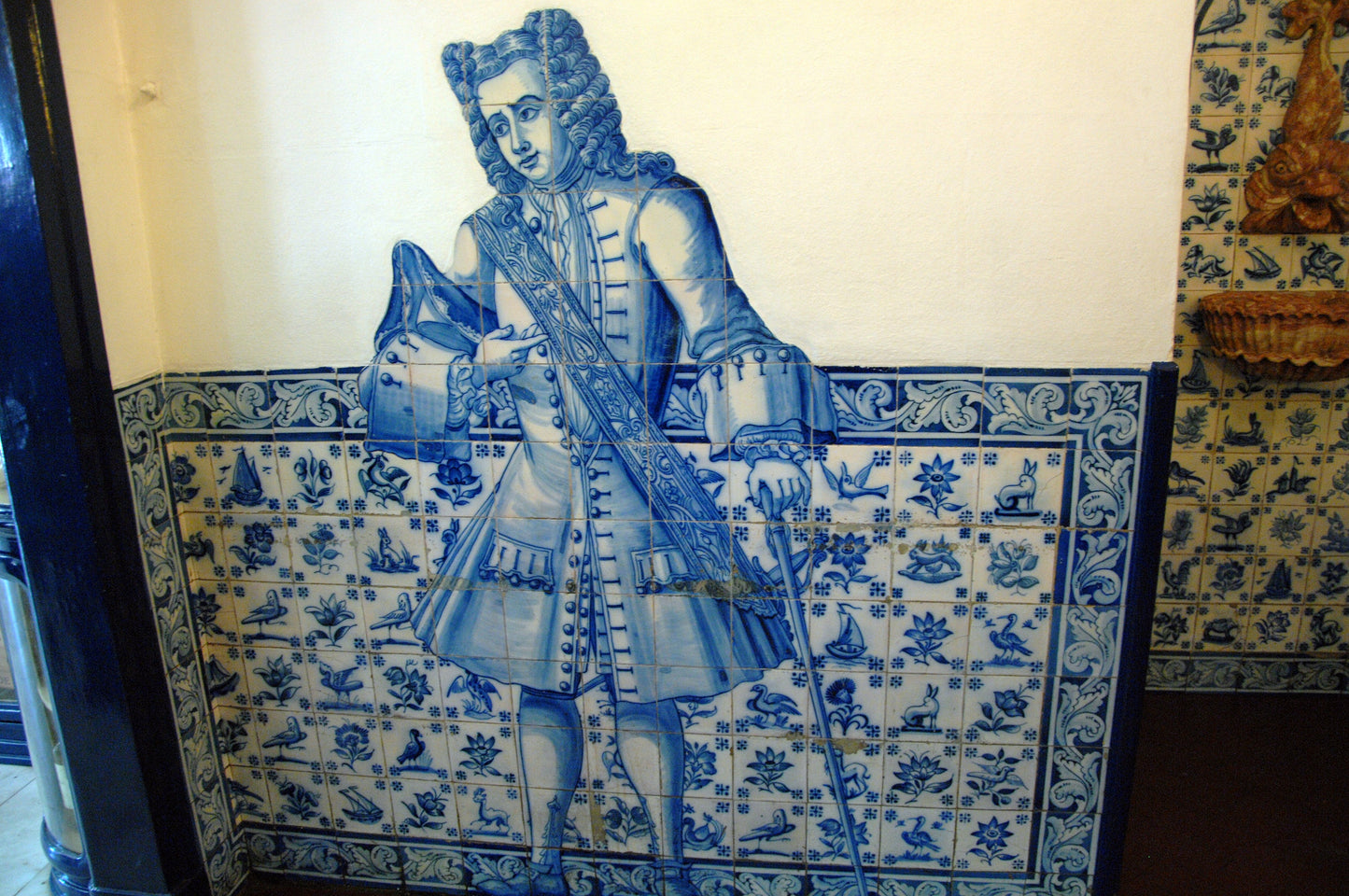Atrio Tiles
Atrio Hoop Earrings Japan Willow Spode Minton Delft Pottery Porcelain Chinoiserie Asian 1" Ships from USA Stainless Steel Gold or Silver
Atrio Hoop Earrings Japan Willow Spode Minton Delft Pottery Porcelain Chinoiserie Asian 1" Ships from USA Stainless Steel Gold or Silver
Couldn't load pickup availability
These earrings are cute small gold hoops 1" with a 6mm wide bottom. They have a Portuguese tile replica inlay. They are a perfect gift and will come with lovely packaging for yourself, a friend, coworker, sister, mom, wife or girlfriend! Perfect little pieces of Portuguese history!
These sweet hoops are 1" in diameter and are 6.3mm wide. They will come in a gift box.
WEAR A PIECE OF HISTORY!
According to Wikipedia: Legend behind the pattern[edit]
In order to promote sales of Minton's Willow pattern, various stories were invented based on the elements of the design. The most famous story usually runs as described below. The story is English in origin, and has no links to China.[6]
The Romantic Fable: Once there was a wealthy Mandarin, who had a beautiful daughter (Koong-se). She had fallen in love with her father's humble accounting assistant (Chang), angering her father. (It was inappropriate for them to marry due to their difference in social class.) He dismissed the young man and built a high fence around his house to keep the lovers apart. The Mandarin was planning for his daughter to marry a powerful Duke. The Duke arrived by boat to claim his bride, bearing a box of jewels as a gift. The wedding was to take place on the day the blossom fell from the willow tree.
On the eve of the daughter's wedding to the Duke, the young accountant, disguised as a servant, slipped into the palace unnoticed. As the lovers escaped with the jewels, the alarm was raised. They ran over a bridge, chased by the Mandarin, whip in hand. They eventually escaped on the Duke's ship to the safety of a secluded island, where they lived happily for years. But one day, the Duke learned of their refuge. Hungry for revenge, he sent soldiers, who captured the lovers and put them to death. The gods, moved by their plight, transformed the lovers into a pair of doves (possibly a later addition to the tale, since the birds do not appear on the earliest willow pattern plates).[7]
Conquered in 1147, Lisbon is the lovely capital of Portugal with its old cobblestone roads and beautiful tiles.
Please feel free to email me with any questions you may have.
🌺 CLICK here to return to my shop:
https://www.etsy.com/shop/Atrio
🌸 Favorite our shop for updates
🌿 Follow us on Instagram @atrio_azulejos
🌿Follow us on Facebook https://www.facebook.com/o.Atrio/
+All items will come in a gift box ready for gift giving.
Although the tiles are water resistant, care should be taken to keep the tiles and metal out of water and away from lotions, including cosmetics, sunscreen, hairspray, etc. The chemicals in these products will dull the finish on the tiles.
According to Wikipedia:
The first affiliation between Portugal and Japan started in 1543, when the Portuguese explorers landed in the southern archipelago of Japan. This period of time is often entitled Nanban trade, where both Europeans and Asians would engage in mercantilism. The Portuguese at this time would found the port of Nagasaki, through the initiative of the Jesuit Gaspar Vilela and the Daimyo lord Ōmura Sumitada, in 1571.
The expansion for commerce extended Portuguese influence in Japan, particularly in Kyushu, where the port became a strategic hot spot, after the Portuguese assistance to Daimyo Sumitada on repelling an attack on the harbor by the Ryūzōji clan in 1578.
The cargo of the first Portuguese ships upon docking in Japan, were basically cargo coming from China (silk, porcelain, etc.). The Japanese craved these goods, which were prohibited from the contacts with the Chinese by the Emperor, as punishment for the attacks of the Wokou piracy. Thus, the Portuguese acted as intermediaries in Asian trade.
In 1592 the Portuguese trade with Japan, started being increasingly challenged by Chinese smugglers on their reeds, in addition to Spanish vessels coming to Manila in 1600, the Dutch in 1609, and English in 1613.
One of the many things that the Japanese were interested in, were Portuguese fire guns. The first three Europeans to arrive in Japan in 1543, were Portuguese traders António Mota, António Peixoto and Francisco Zeimoto (also presumably Fernão Mendes Pinto). They arrived at the southern tip of Tanegashima, where they would introduce Firearms to the local population. These muskets would later receive the name after its location.
Because Japan was in the midst of a civil war, called the Sengoku period, the Japanese holstered Portuguese guns of a lighter and better mechanism, with an accurate aim. The Famous Daimyo who virtually unified Japan, Oda Nobunaga, made extensive use of guns ( arquebus ) playing a key role in the Battle of Nagashino. Within a year, Japanese smiths were able to reproduce the mechanism and began to mass-produce the Portuguese arms. And just 50 years later, his armies were equipped with a number of weapons perhaps greater than any contemporary army in Europe. The weapons were extremely important in the unification of Japan under Toyotomi Hideyoshi and Tokugawa Ieyasu, as well as in the invasion of Korea in 1592 and 1597. Europeans brought by trade not only weapons, but also soap, tobacco, and other unknown products in Feudal Japan.
After the Portuguese first made contact with Japan in 1543, a large scale slave trade developed in which Portuguese purchased Japanese as slaves in Japan and sold them to various locations overseas, including Portugal itself, throughout the sixteenth and seventeenth centuries.[1][2] Many documents mention the large slave trade along with protests against the enslavement of Japanese. Japanese slaves are believed to be the first of their nation to end up in Europe, and the Portuguese purchased large amounts of Japanese slave girls to bring to Portugal for sexual purposes, as noted by the Church in 1555. King Sebastian feared that it was having a negative effect on Catholic proselytization since the slave trade in Japanese was growing to massive proportions, so he commanded that it be banned in 1571[3][4]
Japanese slave women were even sold as concubines, serving on Portuguese ships and trading in Japan, mentioned by Luis Cerqueira, a Portuguese Jesuit, in a 1598 document.[5] Japanese slaves were brought by the Portuguese to Macau, where some of them not only ended up being enslaved to Portuguese, but as slaves to other slaves, with the Portuguese owning Malay and African slaves, who in turn owned Japanese slaves of their own.[6][7]
Hideyoshi was so disgusted that his own Japanese people were being sold en masse into slavery on Kyushu, that he wrote a letter to Jesuit Vice-Provincial Gaspar Coelho on 24 July 1587 to demand the Portuguese, Siamese (Thai), and Cambodians stop purchasing and enslaving Japanese and return Japanese slaves who ended up as far as India.[8][9][10] Hideyoshi blamed the Portuguese and Jesuits for this slave trade and banned Christian proselytizing as a result.[11][12]
Some Korean slaves were bought by the Portuguese and brought back to Portugal from Japan, where they had been among the tens of thousands of Korean prisoners of war transported to Japan during the Japanese invasions of Korea (1592–98).[13][14] Historians pointed out that at the same time Hideyoshi expressed his indignation and outrage at the Portuguese trade in Japanese slaves, he himself was engaging in a mass slave trade of Korean prisoners of war in Japan.[15][16]
Fillippo Sassetti saw some Chinese and Japanese slaves in Lisbon among the large slave community in 1578.[17][18][19][20][21]
The Portuguese "highly regarded" Asian slaves like Chinese and Japanese, much more "than slaves from sub-Saharan Africa".[22][23] The Portuguese attributed qualities like intelligence and industriousness to Chinese and Japanese slaves which is why they favored them more.[24][25][26][27]
In 1595 a law was passed by Portugal banning the selling and buying of Chinese and Japanese slaves.[28]
Language[edit]
As a result of the Portuguese arrival to Japan, after a continuous influx of trade between Asia and Europe, Japanese vocabulary absorbed words of Portuguese origin as well as Portuguese of Japanese. Among its great part, these words mainly refer to products and customs that arrived through Portuguese traders.
Portuguese was the first occidental language to have a Japanese dictionary, the Nippo Jisho (日葡辞書, Nippojisho) dictionary or "Vocabvlário da Lingoa de Iapam" ("Vocabulary of the Language of Japan" in old-fashioned orthography), compiled by Jesuits such as João Rodrigues, published in Nagasaki in 1603.
Wear a Piece of History!
🌺ATTENTION: There is a 5% RESTOCKING fee per item PLUS a $3.50 fee for returned items.
🌸🌸🌸🌸🌸🌸🌸🌸🌸🌸🌸🌸🌸🌸🌸🌸🌸🌸
🌸
The term Azulejo or Tile dates back to the time of Arab occupation of the Iberian Peninsula. The term "azulejo is derived from the Arab word (al zulej) which means a smooth and polished stone. It wasn't until the 16th century that the process was perfected into the tile we know today.
🌸🌸🌸🌸🌸🌸
+ Please note that some of our items will come with a tag stating "Return only accepted if tag is attached". There are no exceptions to this policy. 🌺ATTENTION: There is a 5% RESTOCKING fee per item PLUS a $3.50 fee for returned items.
🌸🌸
Although the tiles are water resistant, care should be taken to keep the tiles and metal out of water and away from lotions, including cosmetics, sunscreen, hairspray, etc. The chemicals in these products will dull the finish on the tiles.
🌸🌸🌸
All my tiles are replicas made of polymer clay where the image actually becomes part of the clay through baking. No glue is used in the process. The pieces become waterproof and scratch resistant. Due to the handmade and hand shaped nature of each tile, slight variations will occur, as no two pieces are alike.
🌸🌸🌸🌸
Wear a Piece of History!
QUESTION: Are your tiles real antique Portuguese Azulejo tiles?
ANSWER: Absolutely not. In our description of each item, we try to call attention to the theft and destruction of antique Portuguese tiles. Even the tiles found in flea markets and antique stores were most likely stolen off a building during the night. We have seen entire home facades disappear during the night to thieves. Thankfully, Portugal just passed a law declaring this theft a crime. We can only hope that it will one day be enforced.
For this reason, we have no part in this despicable crime. We make our own tiles from polymer clay. Ceramic would be far too heavy for earrings and impossible to mold into the shapes we want. For the hoops, we mold the clay as thin as we can get it, so that it will look pretty inside the hoops.
QUESTION: What kind of metal is it?
ANSWER: SOLID STAINLESS STEEL
If it is gold tone, it has a real gold wash. It is not gold plated. Stainless steel is hypoallergenic and lightweight.
Share










